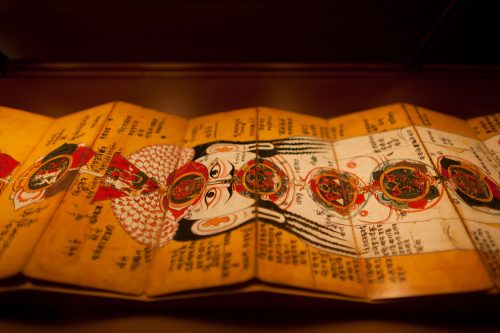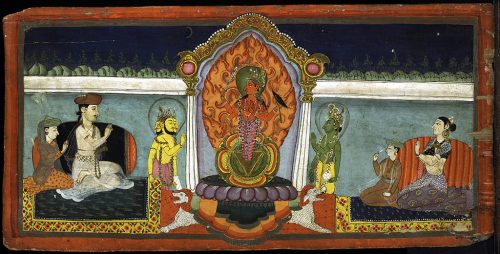TBI Blogs: Discover Why an 11th-Century Collection of Stories Is as Riveting and Important Today as It Was Then
Indian mythology and folk tales are rich with interesting characters, amazing stories, and valuable lessons. Discover an 11th-century compendium of these incredible narratives that has stood the test of time as one of the world’s finest collection of stories.

Indian mythology and folk tales are rich with interesting characters, amazing stories, and valuable lessons. Discover an 11th-century compendium of these incredible narratives that has stood the test of time as one of the world’s finest collection of stories.
A few days ago, sitting in a public library in Nagpur, I was flipping through the pages of an enchanting book written by Arshia Sattar in 1994, called Tales from the Kathāsaritsāgara.
Sattar is a renowned Indian scholar, translator and writer, known particularly for her interest in South Asian languages. Her body of works includes The Ramayana of Valmiki, Kishkindha Tales, and Pampa Sutra, to name a few. The latest addition to this list is the Ramayana for Children, decorated excellently with illustrations by Sonali Zohra, an artist Sattar found on the internet.
Do grab a copy of the book and indulge in some sound reading.

Image Source: Flickr
What does Kathasaritsagara mean?
Kathasaritsagara, meaning Ocean of the Streams of Stories, is an 11th-century collection of Indian legends, fairy tales, and folk tales, retold in Sanskrit by a Kashmiri Saivite Brahmin named Somadeva.
What exactly led Somadeva to write the Kathasaritsagara?
According to Kalhana’s Rajatarangini (a historical chronicle on the kings of Kashmir), King Anantadeva’s reign was full of political turbulence. Anantadeva’s wife Suryavati was known for supporting the cause of building temples and monasteries. The Kathasaritsagara was retold by Somadeva to divert the queen’s mind from the disturbance around her and help her acquire a state of higher learning.
Were the stories conceived by Somadeva or were they borrowed from other sources?
A brief background of the Kathasaritsagara is indispensable before answering this question.
Gunadhya is the presumed author of a book that goes by the name of Brihatkatha (the Great Story). The book was written by him on a bark using his own blood in the Paisaci language. Paisaci is believed to be one of the many dialects of Prakrit that flourished in India.
A Satvahana king rejected the Brihatkatha outright, as it was composed in the most crude and unsophisticated tongue. Books in those days were nothing but barks of trees tied together with a twig, something similar to what we call “manuscripts” these days . The king’s gesture devastated Gunadhya, and he reduced six of his manuscripts to flames. All that remains today of the Brihatkatha is the seventh manuscript containing the adventures of Naravahanadatta, a Vidyadhara prince.
Somadeva supposedly adapted this seventh manuscript into his classic, the Kathasaritsagara.

Image Source: Flickr
Was Somadeva the lone and only compiler of the Brihatkatha?
Ksemendra, a Kashmiri poet of the 11th century, compiled the Brihatkatha 30 years prior to Somadeva, but Sanskrit scholars deemed his works “all form and no substance”.
Somadeva’s compilation is highly praiseworthy, although it suppresses the Naravahanadatta narrative through a number of Kashmiri legends besides the tales of Nala and Damyanti (a story from the Vana Parva of the Mahabharata), and Vetalpanchavimshati (25 tales of Vetala).
What allows Kathasaritsagara to stand out?
A peculiarity of this text is its narrative in the first person, unlike the other Sanskrit texts of the same period. Another feature that sets it apart from other Indian classics is its liberal approach towards life where people need not behave as per social standing. It is a celebration of the earthly life sans the diktats of attaining moksha or liberation. The book is most presumably written for the merchant class, for trade ties were at their peak during the time of Somadeva.
Is the book secular?
Though the book draws heavily from Hinduism and Buddhism, it clearly does not endorse the views of any one religion. The narrative mentions a number of classes such as the Picasas, Brahmans, Kshatriyas, and Vidyadharas. However, Somadeva has neither glorified nor criticized the castes and classes, thus reducing their relevance in his text. A number of gods and goddesses frequently appear in the narrative, but they are merely providers of boons and curses.
More often than not, Yakshas, Yoginis, and ascetics intercede on behalf of the gods to save characters from eternal doom.
Image Source: Flickr
There happens to be an exception here though.
There is a class which has been extensively discussed – the dubious Vidyadharas, who are celestial beings with characteristics similar to those of the Gandharvas and the Siddhas. The Vidyadharas are kamarupin (taking shapes at will), khechara (moving in air), and priyamvada (sweet-spoken). However, they are clearly mortal, and have limited powers.
What kind of stories will the readers get to enjoy?
The orientation of the text is a subject of speculation and research. Finding stories of Indra and Ahalya, Chanakya, formation of Pataliputra (modern-day Patna), and sage Valmiki creating Kusa from a blade of grass is amusing. One story sure to catch everybody’s attention is that of Lohajangha, a character who meets Vibhishana, the crowned king of Lanka after Ravana.
Is Kathasaritsagara the source of the Canterbury Tales?
The outer frame tightly binds a number of inner frames in Kathasaritsagara – essentially a framed narrative. However, when compared to the epics, it has a relatively simple structure.
The Arabian Nights and the Canterbury Tales (also framed narratives themselves) have roots either in the Panchatantra or the Kathasaritsagara. The origin of framed narratives outside the subcontinent has divided scholars. But, they have ascertained that India has long been home to the concept of framed narratives and is the motherland of stories that today have a global dimension.
Readers may note that Orientalists never valourised Kathasaritsagara as it subverted their belief that Indian texts were always religious and material life was completely lacking in them. Kathasaritsagara deals primarily with the material aspects of life, and this completely surprised them.
What about the Panchatantra? How is it different from the Kathasaritsagara?
The Panchatantra is different from the Kathasaritsagara in many forms and ways. It is a collection of stories Pundit Vishnu Sharma narrates to King Amarashakti’s three princes in the 1st century B.C. It abounds in tales of animals dwelling in the tropical forests of India and touches every aspect of human behaviour.
Vishnu Sharma bases the 84 stories on five techniques: Mitra Bheda (loss of friends), Mitra Labha (gaining friends), Suhrudbheda (causing dissension between friends), Vigraha (war and peace), and Sandhi (compromise).

Why should a reader include Somadeva’s classic in his library?
Kathasaritsagara is an intersection of pan-Indian classical ideas meeting local and regional forms. It refrains from being preachy, though it is not completely devoid of a moral intent. Sanskrit verses are replete with wisdom and demand contemplation. For example, “Panko hi nabhasi kshiptaha, ksheptuhu murdhani patati” (“Dirt thrown at the sky, falls on the head of the thrower”).
This monumental work is a must-read for those hunting for stories that contain the flavour of Indian soil. It is our pride, our gift to the world of story-telling.
Get a copy of Sattar’s Tales from the Kathasaritsagara here. You can also read C.H. Tawney’s 1924 translation of the Kathasaritsagara online, for free, here.
Like this story? Or have something to share? Write to us: [email protected], or connect with us on Facebook and Twitter.
NEW: Click here to get positive news on WhatsApp!
This story made me
- 97
- 121
- 89
- 167
Tell Us More
We bring stories straight from the heart of India, to inspire millions and create a wave of impact. Our positive movement is growing bigger everyday, and we would love for you to join it.
Please contribute whatever you can, every little penny helps our team in bringing you more stories that support dreams and spread hope.




















